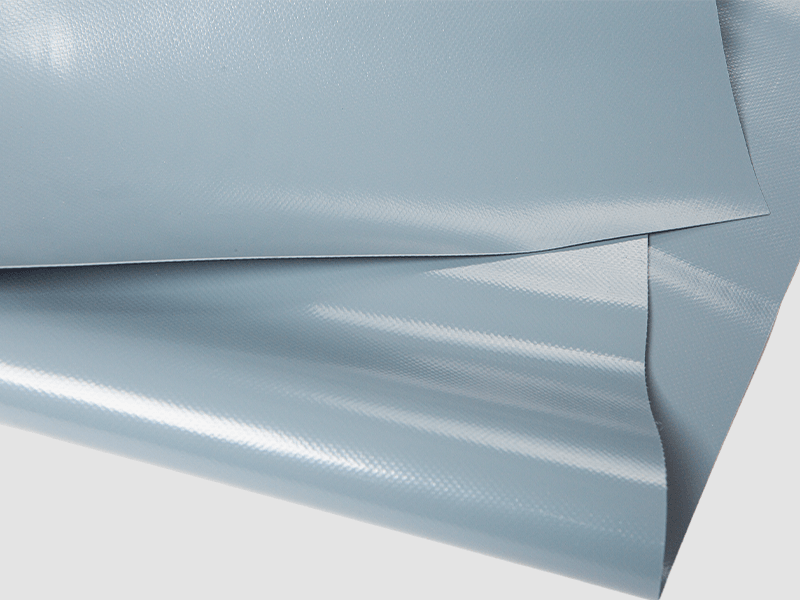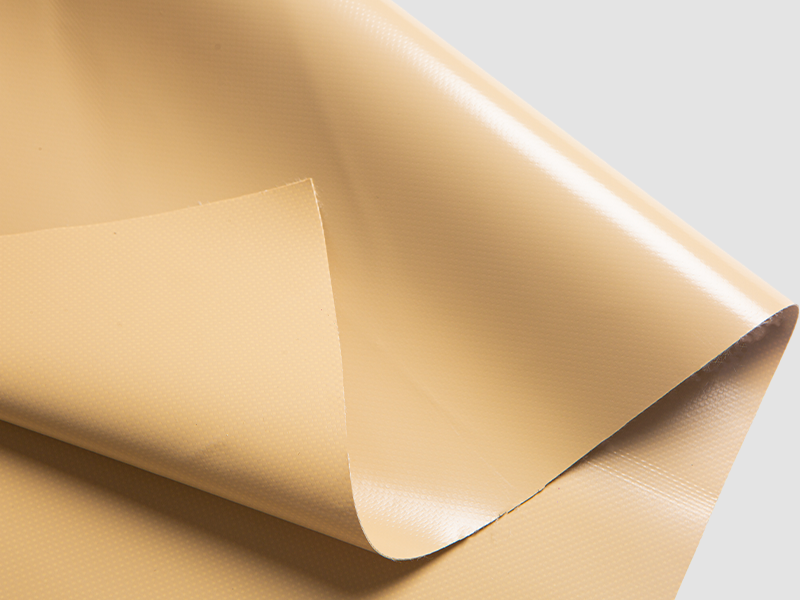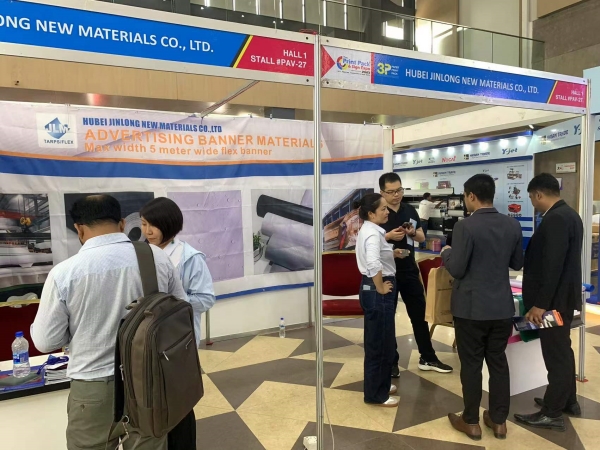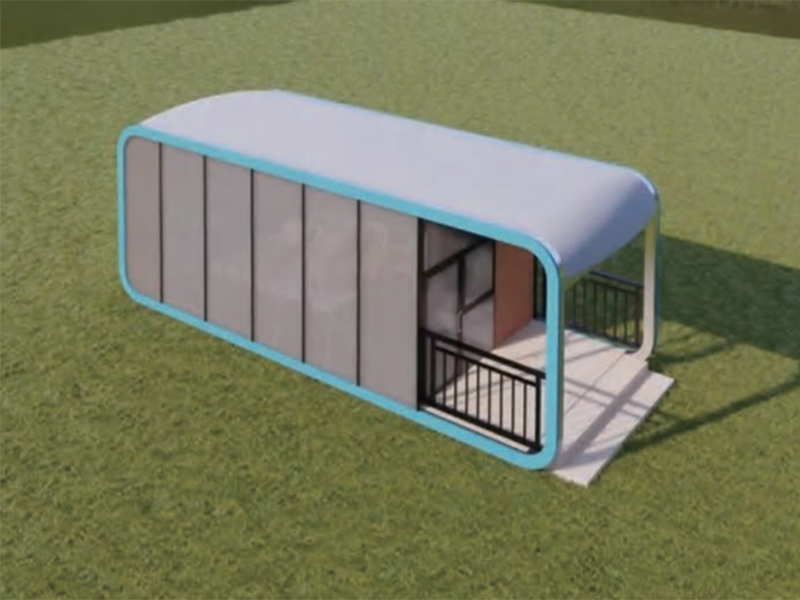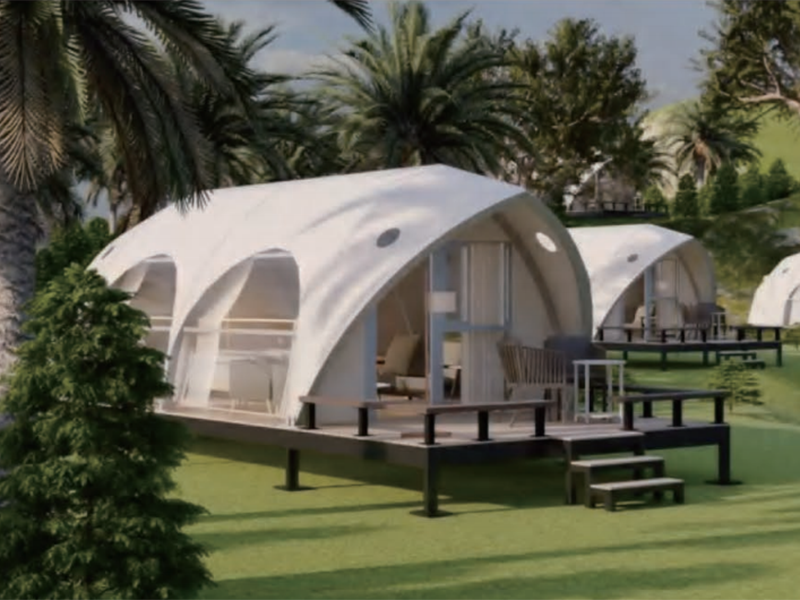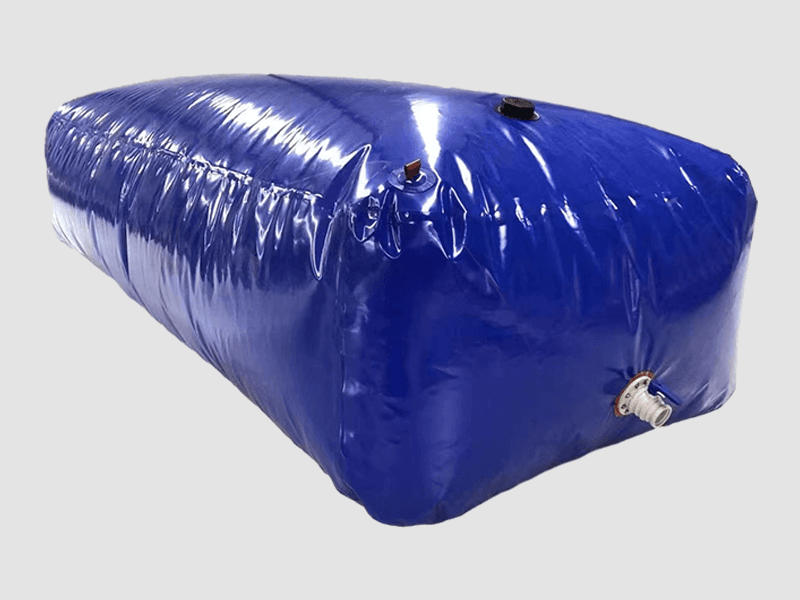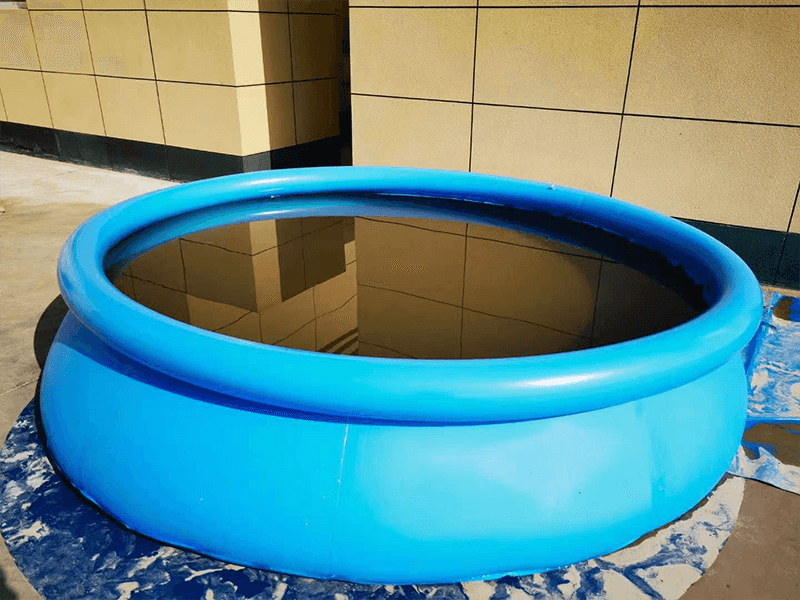Introduction to PVC Tensile Fabric
What is PVC Tensile Fabric?
PVC tensile fabric refers to a high-performance architectural material made by coating polyester fabric with polyvinyl chloride (PVC). This synthetic composite is engineered to withstand substantial tension, making it an ideal material for tensile membrane structures. These structures, characterized by their sleek curves and lightweight properties, rely on tension rather than compression or bending to support loads. The PVC coating makes the fabric weather-resistant, UV-stable, flame-retardant, and flexible enough to be molded into complex forms.
Unlike traditional construction materials like steel or concrete, PVC tensile fabric enables dynamic, fluid forms that allow architects to explore innovative designs. Its translucent nature can also provide soft natural lighting, reducing energy consumption and enhancing user comfort.
Brief History and Evolution
The roots of tensile fabric structures can be traced back to nomadic tents and sailing vessels, where fabrics were used under tension to create stable yet mobile forms. However, the development of modern tensile structures began in the mid-20th century with advances in materials science. Architects and engineers like Frei Otto, a pioneer in lightweight tensile architecture, played a significant role in bringing fabric-based construction into the mainstream. His design for the 1972 Munich Olympic Stadium is still celebrated for its visionary use of tensile membrane structures.
PVC-coated polyester emerged in the 1960s as a commercially viable solution due to its excellent performance and cost-effectiveness. Over the decades, it has been refined for better UV resistance, enhanced fire retardancy, and longer lifespan. Today, PVC tensile fabric is one of the most commonly used materials for lightweight roofing systems around the world.
Why Choose PVC for Tensile Structures?
PVC tensile fabric offers a unique combination of strength, flexibility, and economy. There are several compelling reasons why designers, builders, and developers prefer PVC over other materials for tensile architecture:
-
Affordability : Compared to PTFE (polytetrafluoroethylene) or ETFE (ethylene tetrafluoroethylene), PVC-coated fabrics are far more economical while still delivering strong performance.
-
Design Freedom : PVC tensile fabric can be cut, welded, and shaped into dramatic, organic curves that traditional materials cannot achieve. This allows architects to push creative boundaries.
-
Lightweight Construction : The fabric's low weight reduces the need for heavy support structures, leading to savings on materials, transport, and installation time.
-
Fast Installation : Tensile structures using PVC fabric can be fabricated and erected relatively quickly compared to conventional roofing systems.
-
Weather Protection : Modern PVC membranes are engineered to be waterproof, UV-resistant, and stable across a wide range of temperatures and environmental conditions.
-
Translucency : The fabric allows diffused daylight to filter through, minimizing the need for artificial lighting and creating a pleasant interior environment.
-
Environmental Benefits : With lower material consumption, potential for recyclability, and reduced construction waste, PVC tensile structures align with sustainable building practices.
Together, these advantages make PVC tensile fabric an attractive option for projects where performance, visual impact, and cost-efficiency are critical.
Properties and Characteristics of PVC Tensile Fabric
Understanding the technical and physical properties of PVC tensile fabric is essential to appreciating its performance in architectural and industrial applications. This section explores the key characteristics that make PVC-coated polyester an ideal choice for tensile structures.
Material Composition: PVC-Coated Polyester
PVC tensile fabric is composed of two primary layers:
-
Polyester Base Fabric
The core of the material is a woven polyester scrim, which provides mechanical strength. This high-tenacity polyester yarn offers excellent tensile strength and dimensional stability, forming the structural backbone of the fabric. -
PVC Coating
The base fabric is coated on both sides with liquid polyvinyl chloride (PVC), which is then heat-treated or cured to create a smooth, sealed surface. This coating adds protective and performance-enhancing properties such as water resistance, UV protection, and fire retardancy.
Additional surface treatments, like lacquering with PVDF (polyvinylidene fluoride), can improve resistance to dirt, mold, and environmental wear. These coatings not only prolong the fabric’s lifespan but also reduce maintenance costs.
Tensile Strength and Durability
Tensile strength is one of the most crucial factors in the design and performance of a tensile structure. PVC-coated polyester is known for its excellent mechanical strength under both tension and shear stress. Standard tensile strengths typically range between 2500N/5cm and 8500N/5cm, depending on the fabric’s weight and weave.
This makes it suitable for applications that require large spans, resistance to wind uplift, and support for heavy snow or rain loads. Additionally, the durability of the fabric allows it to perform well over time under constant tension without significant deformation or fatigue.
Weather Resistance (UV, Rain, Wind)
One of the most valuable qualities of PVC tensile fabric is its ability to endure harsh environmental conditions. It is engineered to resist:
-
UV Radiation : Long-term exposure to sunlight can degrade most materials, but PVC membranes are formulated with UV stabilizers to withstand prolonged sun exposure. This helps prevent brittleness and discoloration.
-
Rain and Moisture : The PVC coating creates a waterproof barrier that prevents water ingress. High-frequency welding ensures that seams are watertight, making the fabric ideal for roofing applications.
-
Wind Loads : Thanks to its tensile nature and ability to flex under pressure, PVC tensile fabric can absorb wind forces rather than resist them with rigidity. This makes the structure more resilient during storms or high-wind conditions.
Whether in tropical rainstorms or desert heat, PVC tensile structures maintain their integrity and appearance over time.
Fire Retardancy Standards
Fire safety is a critical aspect of any building material. PVC tensile fabrics are manufactured to comply with international fire-retardancy standards, including:
-
NFPA 701 (USA)
-
BS 7837 (UK)
-
DIN 4102-B1 (Germany)
-
AS/NZS 1530.2 (Australia/New Zealand)
These certifications ensure that the material will self-extinguish once the source of fire is removed and will not contribute significantly to the spread of flames. Some advanced versions of PVC fabric even meet stricter standards for public spaces and high-occupancy buildings, making them suitable for stadiums, airports, and shopping malls.
Weight and Flexibility
PVC tensile fabrics come in a range of weights, typically from 450 grams/m² to 1350 grams/m² , with heavier fabrics generally offering better durability and higher tensile strength. However, even the heaviest grades remain far lighter than traditional building materials, reducing structural loads.
This light weight, combined with inherent flexibility, makes the material easy to transport, manipulate, and install. Its flexibility allows it to be tensioned over complex forms and curvatures, supporting the creation of iconic, sculptural architecture.
Flexibility also helps absorb mechanical shocks and movement, reducing the risk of tearing or fatigue. The ability to bend, fold, and stretch gives architects the creative freedom to develop fluid, organic shapes that would be impossible with rigid materials.
Lifespan and Longevity
The average lifespan of PVC tensile fabric varies depending on factors like fabric quality, climate, exposure levels, and maintenance. High-quality PVC-coated polyester fabrics with protective PVDF top coatings can last 15 to 20 years , and in some cases even longer.
The main threats to longevity include:
-
UV degradation over time, especially in extreme climates.
-
Mechanical damage from sharp objects or excessive tension.
-
Dirt accumulation that can degrade the surface and aesthetics if not cleaned regularly.
Nonetheless, with proper design, installation, and routine care, the functional lifespan of a PVC tensile membrane can often exceed initial expectations. Re-coating and repair options are also available to further extend service life without replacing the entire structure.
Advantages and Disadvantages of PVC Tensile Fabric
PVC tensile fabric is widely used in modern architecture and temporary structures due to its balance of performance, aesthetics, and cost-effectiveness. However, like any material, it comes with both strengths and limitations. In this section, we will explore the most significant advantages and disadvantages of PVC tensile fabric to give a balanced perspective on its practical use.
Advantages of PVC Tensile Fabric
1. Cost-Effectiveness
One of the most notable benefits of PVC tensile fabric is its affordability. Compared to alternative tensile materials like PTFE (Polytetrafluoroethylene) or ETFE (Ethylene Tetrafluoroethylene), PVC is significantly less expensive both in raw material cost and installation.
-
Material Savings : Due to its lightweight nature, supporting structures can be minimal, reducing the need for heavy steel or concrete components.
-
Reduced Labor Costs : The ease of handling and faster installation times contribute to lower labor expenses.
-
Maintenance Savings : With protective coatings, the material requires minimal upkeep over its lifespan, adding to its cost-effectiveness.
This makes PVC tensile fabric an ideal choice for projects with tight budgets or large-scale coverage requirements.
2. Design Flexibility
PVC fabric allows for a high degree of architectural creativity. Its inherent flexibility means it can be tensioned over complex geometric shapes, creating visually striking structures that stand out.
-
Curved and Organic Forms : The fabric’s pliability allows for sweeping arcs, conical shapes, and domes.
-
Large Spans : It can cover large areas without internal supports, perfect for open environments like stadiums and auditoriums.
-
Color and Finish Options : PVC fabrics can be manufactured in a variety of colors and opacities, and can even be printed on for branding or decorative purposes.
This freedom opens up endless possibilities for architects and designers looking to push boundaries.
3. Lightweight
The lightweight nature of PVC tensile fabric (generally between 450–1350 g/m²) significantly reduces the structural load on buildings. This has several advantages:
-
Smaller Foundations : Less structural support is needed, saving on construction time and materials.
-
Ease of Transport : Fabric panels are easy to roll, ship, and lift into place.
-
Portable Applications : Its low weight makes it ideal for temporary installations and rapid-deployment shelters.
This quality also contributes to the overall sustainability of the structure by reducing the carbon footprint during construction.
4. Quick Installation
PVC tensile fabric structures can be designed and installed in a fraction of the time it would take to build conventional roofing systems.
-
Pre-fabricated Panels : The fabric is cut, welded, and preassembled off-site, streamlining on-site work.
-
Simplified Structural Requirements : Minimal framing means fewer components and less complexity.
-
Shorter Construction Timelines : A shorter build time means less disruption to surrounding areas and faster project delivery.
For projects requiring speed—such as event venues, emergency shelters, or seasonal structures—this advantage is critical.
5. Aesthetic Appeal
Tensile fabric structures have a modern, elegant appearance that can be both functional and iconic. Many landmark architectural projects across the world use PVC membranes for their clean lines and sculptural qualities.
-
Translucency : Allows soft, natural daylight to filter through, enhancing the ambiance.
-
Dynamic Designs : Movement and form become architectural elements, especially with wind or lighting.
-
Customization : Logos, colors, and lighting effects can be integrated into the design.
This aesthetic potential adds value to commercial properties and public spaces, contributing to brand identity or urban beauty.
Disadvantages of PVC Tensile Fabric
Despite its many strengths, PVC tensile fabric also has certain limitations that should be considered during project planning and material selection.
1. Maintenance Requirements
While PVC is generally low-maintenance, it still requires routine care to maintain its performance and appearance.
-
Cleaning : Dirt, mold, and pollution can accumulate over time, especially in urban or humid environments. Regular cleaning with non-abrasive agents is needed.
-
Surface Wear : Although protective coatings help resist dirt and UV, the surface can degrade with age or improper handling.
-
Water Ponding : Poor design or incorrect tensioning can lead to water pooling, which may cause stretching or damage.
Neglecting maintenance can significantly reduce the fabric’s lifespan and aesthetic appeal.
2. Potential for Damage
PVC tensile fabric is durable, but it’s still a flexible membrane. This means it's more vulnerable to punctures, cuts, or tearing compared to rigid materials.
-
Sharp Objects : Tools, tree branches, or debris in high winds can puncture the surface.
-
Excessive Tension : Improper installation can lead to over-stressing and premature failure.
-
Vandalism : In public spaces, the fabric can be susceptible to intentional damage.
While repairs are usually simple and cost-effective, repeated damage can compromise structural integrity and visual appearance.
3. Limited Lifespan Compared to Other Materials
Though PVC tensile fabric can last 15–20 years or more with proper care, it still has a shorter lifespan than more premium materials like PTFE (up to 30 years) or metal roofing (often 40–60 years).
-
UV Exposure : Prolonged sunlight can cause gradual degradation of the PVC coating.
-
Coating Breakdown : Over time, protective layers like PVDF can wear away, increasing maintenance needs.
-
Color Fading : Especially in darker or brighter colors, UV exposure can lead to fading over the years.
For projects where long-term durability is a critical concern—such as permanent public infrastructure—alternative materials may be more suitable despite the higher initial cost.
Balancing Pros and Cons
PVC tensile fabric represents a smart compromise between affordability, aesthetics, and function. While it may not offer the extreme longevity of more expensive options, its ease of use, visual appeal, and versatility make it a practical choice for a wide range of applications.
Ideal Use Cases Include:
-
Temporary or semi-permanent structures
-
Outdoor canopies, pavilions, and event spaces
-
Sports facilities and recreational centers
-
Creative commercial architecture with visual impact
-
Agricultural and industrial shelters where quick deployment matters
Less Ideal For:
-
High-security environments requiring extreme puncture resistance
-
Long-term fixed structures in areas with intense UV radiation without regular maintenance
-
Applications where lifespan beyond 25 years is essential
Understanding these trade-offs allows project managers and architects to make informed decisions based on their specific needs and constraints.
Applications of PVC Tensile Fabric
PVC tensile fabric is a highly adaptable material used across multiple industries due to its unique blend of strength, flexibility, aesthetics, and cost-efficiency. Whether for permanent structures, temporary installations, or protective shelters, its application spans architectural, industrial, agricultural, and emergency sectors. Below is a detailed exploration of the most common and innovative uses of PVC tensile fabric in various environments.
Architectural Structures
1. Stadiums and Arenas
Large sports venues often require roofing systems that can span vast distances without internal supports. PVC tensile fabric offers the perfect solution through its lightweight and flexible nature.
-
Wide-span Capability : It can cover large areas like spectator seating or entire playing fields without obstructive columns.
-
Natural Light : Its translucency brings in daylight, reducing the need for artificial lighting.
-
Aesthetic Identity : Tensile fabric roofs add modern elegance to stadium design, often becoming iconic landmarks in their own right.
Many Olympic and World Cup stadiums around the world feature PVC membrane roofs for their combination of function and form.
2. Shopping Malls
Shopping centers benefit from covered walkways, atriums, and entry canopies made from PVC tensile fabric.
-
Weather Protection : It shields customers from rain and harsh sun while maintaining an open-air feel.
-
Branding Opportunities : The fabric can be printed with logos or colors to match corporate identity.
-
Visual Appeal : The flowing forms create a luxurious, modern retail experience.
Indoor spaces like food courts or atria can also use PVC fabric for ceiling features and indirect light diffusion.
3. Transportation Hubs
Airports, railway stations, bus terminals, and parking facilities use PVC tensile fabric in roofing and facade elements to enhance both functionality and passenger experience.
-
Large Covered Spaces : Ideal for covering vehicle drop-off areas and open waiting zones.
-
Quick Installation : Perfect for expanding or renovating high-traffic areas with minimal disruption.
-
Daylight Integration : Helps reduce energy consumption and creates pleasant transit environments.
Examples include tensile roof canopies at terminals, covered walkways between buildings, or shaded bus stops.
4. Exhibition Centers
Trade shows, pavilions, and exhibition centers require large, flexible, and quickly erected structures. PVC tensile fabric excels in these roles:
-
Modular Design : Structures can be dismantled, moved, and reassembled as needed.
-
Custom Branding : Surface printing allows for event logos, sponsors, and advertisements.
-
Interior Partitions : The fabric can also be used inside to create zones, banners, and decorative ceilings.
Its ability to create temporary yet high-end experiences makes it a go-to material for organizers and event designers.
Temporary Structures
1. Event Tents
PVC tensile fabric is commonly used for temporary event structures such as wedding tents, concert stages, and corporate pavilions.
-
Fast Setup and Takedown : Lightweight and modular components allow quick deployment.
-
Weatherproofing : Offers reliable protection from sun, rain, and wind.
-
Design Versatility : Can be shaped into elegant marquees or dramatic peaks to enhance the visual impact of events.
PVC tents are often used for both indoor and outdoor occasions due to their flexibility and affordability.
2. Disaster Relief Shelters
In emergency situations such as natural disasters or humanitarian crises, speed and practicality are critical. PVC tensile fabric provides essential shelter solutions.
-
Rapid Deployment : Pre-fabricated shelter units can be transported and installed quickly.
-
Durability : Can withstand harsh weather conditions, providing a safe environment for displaced populations.
-
Reusability : These shelters can be disassembled and reused in different locations or stored for future emergencies.
NGOs and disaster response teams often rely on PVC fabric-based solutions for field hospitals, storage, and sleeping quarters.
Agricultural Applications
1. Greenhouses
PVC tensile fabric is used in greenhouse construction to create controlled growing environments.
-
Light Transmission : The fabric can allow specific levels of light penetration to support photosynthesis.
-
Temperature Control : Offers insulation to maintain internal temperatures, essential for plant growth.
-
Custom Shaping : Allows for dome-shaped or tunnel structures that optimize space and airflow.
PVC-coated structures are an affordable alternative to glass greenhouses, especially in rural or low-income agricultural projects.
2. Livestock Shelters
For farming operations, sheltering livestock from weather extremes is essential. PVC tensile fabric offers an efficient solution:
-
Ventilation : The open structure allows for airflow, reducing heat buildup and improving animal health.
-
Moisture Control : Waterproof membranes prevent rain intrusion while offering shade.
-
Ease of Maintenance : Surfaces can be cleaned quickly and resist mold and microbial growth.
PVC shelters can be used for cattle, poultry, pigs, and other livestock, especially in remote or mobile farming environments.
Industrial Applications
1. Warehouses
PVC tensile fabric warehouses are cost-effective alternatives to traditional steel structures.
-
Large Span Coverage : Offers wide open spaces without interior columns—ideal for storage and logistics.
-
Quick Construction : These can be built in days or weeks instead of months.
-
Temporary or Semi-Permanent : Suitable for seasonal inventory, project-based storage, or construction site usage.
Companies use them for storage of raw materials, vehicles, and equipment when rapid deployment is required.
2. Storage Facilities
Beyond traditional warehousing, PVC fabric is used for specialized storage environments:
-
Salt and Sand Storage : Municipalities store de-icing materials under fabric domes that protect contents from moisture.
-
Grain and Feed Storage : Agricultural operations use fabric shelters for bulk storage in clean, dry conditions.
-
Machinery Protection : Industrial tools and vehicles can be housed under PVC shelters to reduce wear from environmental exposure.
These structures can be outfitted with doors, ventilation systems, and lighting, offering flexibility and scalability for different industrial needs.
Emerging and Niche Applications
With innovation in coatings, sustainability, and form-finding software, PVC tensile fabric is finding new uses in cutting-edge projects:
-
Urban Installations : Art pavilions, pedestrian bridges, or public seating areas now use PVC fabric for shade and visual impact.
-
Floating Structures : Some waterfront applications use PVC membranes for floating roofs, pontoons, or docks.
-
Retail Pop-Ups : Temporary shops and seasonal retail installations often rely on PVC fabric for fast, attractive structures.
As urban density increases and flexible architecture becomes more desirable, PVC tensile fabric continues to evolve in its role across industries.
Conclusion
The adaptability of PVC tensile fabric makes it an invaluable material across architecture, events, agriculture, and industry. Its ability to offer cost-effective, rapidly deployable, and aesthetically appealing solutions is unmatched by many conventional materials.
Whether providing shade in a sports arena, housing emergency relief efforts, covering a greenhouse, or forming a dramatic event space, PVC tensile fabric meets the needs of functionality, speed, and style. As material technology continues to evolve, we can expect its applications to expand even further into innovative and sustainable design territory.
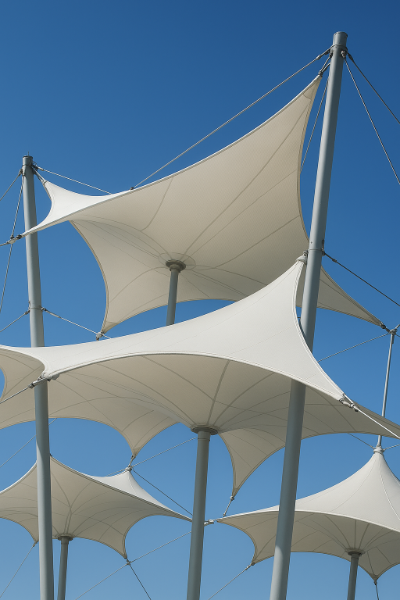
Installation Process of PVC Tensile Fabric
Installing a PVC tensile fabric structure is a multi-phase process that combines engineering precision, on-site expertise, and logistical coordination. The success of the final structure depends not only on the quality of the materials but also on proper handling during installation. Below is a comprehensive overview of the key stages in the installation of PVC tensile fabric, including common mistakes to avoid.
1. Site Preparation
Before the actual installation of the fabric, site preparation is critical. This phase lays the foundation for the structure’s stability and longevity.
Site Survey and Soil Testing
Engineers must evaluate soil type, ground stability, and environmental conditions (e.g., wind load, snow load, rainfall intensity). These data points influence the design and anchoring requirements.
Foundation Works
Foundations—typically concrete blocks or footings—are laid to anchor the support columns and perimeter cable systems. In temporary setups, ballast systems or ground anchors may be used instead of concrete.
Utility Integration
Power lines, drainage systems, lighting, and water access (if needed) are incorporated during this stage. Proper drainage planning is essential to prevent water pooling under or on the fabric.
2. Fabrication and Cutting
After design finalization, the PVC fabric panels are fabricated off-site using precision machinery. This ensures consistency, accuracy, and efficiency.
Computer-Aided Design (CAD)
Engineers use CAD and form-finding software to create 3D models of the tensile structure, determining panel shapes, cut patterns, and connection points.
Fabric Cutting
Large-format plotters or automated cutting tables are used to cut the PVC-coated polyester fabric. Panels are labeled to ensure correct orientation and assembly.
Welding and Seaming
High-frequency welding, hot air welding, or radio frequency welding bonds the fabric panels into large, waterproof sheets. These seams must be durable, UV-resistant, and airtight to prevent leaks and premature wear.
Edge Reinforcement
Stress points and panel edges are reinforced with additional layers, keder strips, or steel cables. These reinforcements ensure proper tension distribution once installed.
3. Attachment Methods
Once on site, the PVC fabric is attached to the main structural elements—be it masts, frames, or cables—using various mechanical methods.
Keder Rails and Channels
A common attachment system, especially in modular and retractable designs. The keder edge (a bead inserted into a sleeve) is slid into an aluminum extrusion or channel mounted on the frame.
Clamps and Plates
Steel plates or clamps are used to grip and stretch the fabric at corners or stress points. These clamps are designed to hold the fabric securely without tearing or slippage.
Lacing and Rope Systems
Traditional lacing techniques are used in smaller structures or where quick assembly/disassembly is required. This system allows for flexible adjustment but offers less precision than welded or keder systems.
Bolted Connections
Heavy-duty bolts or brackets may be used for industrial-scale installations where high wind or snow loads are expected.
Membrane to Structure Integration
Fabric is connected to main structural supports like compression rings, cables, or poles using custom-designed brackets and fittings. The system must allow for uniform load transfer across the surface.
4. Tensioning and Pre-Stressing
Tensioning is the most crucial part of installing a tensile membrane. Proper tensioning ensures the structure's integrity, prevents sagging, and extends the fabric’s lifespan.
Mechanical Tensioning
Hydraulic jacks, turnbuckles, or winch systems are used to apply controlled force across fabric panels, ensuring uniform distribution.
Sequential Tensioning
Panels are tensioned in a specific sequence, often starting from the center and working outwards or from fixed points to free edges. This method avoids fabric distortion or overstressing.
Tension Monitoring
Digital load sensors or tension meters may be used to monitor real-time stress on critical components during installation, ensuring safety margins are maintained.
Thermal Expansion Considerations
Installers must account for temperature changes. PVC membranes expand in heat and contract in cold, so tensioning typically occurs at moderate ambient temperatures to avoid overstretching or slackness later.
5. Common Mistakes to Avoid
Despite advancements in design and materials, installation failures can still occur due to human error, inadequate preparation, or environmental miscalculations. Some common pitfalls include:
Incorrect Tensioning
Over-tensioning can tear the fabric or overstress support elements, while under-tensioning leads to sagging, fluttering, and ponding.
Poor Seaming or Welding
Low-quality welds or misaligned seams may cause leaks or compromise the structural integrity of the membrane.
Improper Drainage Planning
Failure to slope the membrane or install proper drainage systems can result in water ponding, which increases the risk of fabric stretching and collapse.
Ignoring Local Climate Loads
Structures must be designed and installed based on regional environmental factors like snow accumulation, wind patterns, or seismic activity.
Unskilled Labor
Using untrained laborers can lead to misaligned attachments, tension inconsistencies, and safety hazards. It’s crucial to use certified installers familiar with tensile systems.
Safety Considerations
Safety is paramount during installation, particularly in large-scale structures or high elevations. Teams must follow strict protocols to prevent accidents.
-
Fall Protection : Harnesses, scaffolding, and temporary guardrails must be used during high-elevation work.
-
Weather Monitoring : Installation should be scheduled during favorable weather conditions. High winds or rain can be hazardous when working with large fabric panels.
-
Rigging Safety : Cranes and lifting equipment should be inspected regularly, and only certified operators should handle heavy lifting.
-
Team Coordination : Proper communication and defined roles reduce confusion and improve efficiency during high-stress operations like tensioning.
Post-Installation Inspection
Once the installation is complete, a thorough inspection must be carried out before the structure is put to use.
-
Visual Inspection : Check for visible wrinkles, tears, or loose attachments.
-
Tension Verification : Ensure all panels are evenly stressed and that no area is slack or overstretched.
-
Seam Checks : Confirm all welded joints are intact and waterproof.
-
Drainage Tests : Simulate rainfall (if possible) to verify proper water flow and drainage.
-
Structural Check : Inspect anchoring systems and support members for correct alignment and secure connection.
Documentation of the installation process and inspection reports is essential for future maintenance and warranty validation.
Conclusion
The installation of a PVC tensile fabric structure is a precise and highly coordinated process that involves careful site analysis, skilled fabrication, and expert assembly. From initial groundwork to final tensioning, every step requires attention to detail to ensure that the structure performs well over its intended lifespan.
With proper planning, qualified personnel, and adherence to best practices, PVC tensile fabric structures can be installed efficiently, safely, and successfully—bringing functional, beautiful, and durable spaces to life in both temporary and permanent settings.
Maintenance and Repair of PVC Tensile Fabric
PVC tensile fabric structures, while known for their durability and low-maintenance profile, still require regular care to maintain their appearance, performance, and safety. Over time, exposure to the elements, pollution, and mechanical stress can degrade the material or its connections. A well-maintained PVC tensile membrane can last well over a decade with minimal issues. This section provides an in-depth look into proper maintenance procedures, inspection practices, repair strategies, and lifespan-extension techniques.
1. Regular Cleaning Procedures
Cleaning not only preserves the fabric’s aesthetic quality but also prevents long-term damage caused by dirt, bird droppings, mold, and industrial pollutants.
Recommended Cleaning Frequency
-
Every 6–12 Months : For structures in urban or industrial areas with high pollution levels.
-
Annually : In rural or less exposed environments.
-
After Major Events : Following construction, storms, or periods of heavy use, cleaning may be necessary.
Cleaning Equipment and Materials
-
Soft Brushes or Sponges : To avoid scratching the PVC coating.
-
Low-Pressure Water Systems : Such as garden hoses or soft-wash machines.
-
Mild Detergents : Use pH-neutral, non-abrasive cleaning agents.
-
Avoid Harsh Chemicals : No solvents, bleaches, or petroleum-based products, which can weaken or discolor the fabric.
Step-by-Step Cleaning Process
-
Rinse Surface : Remove loose dirt and dust using water.
-
Apply Soap Solution : Use a diluted cleaning solution with a sponge or cloth.
-
Gently Scrub : Focus on stained or high-traffic areas.
-
Rinse Thoroughly : Ensure all detergent residue is washed away.
-
Allow to Air Dry : Ensure the fabric is completely dry to prevent mold growth.
Some structures may require rope access teams or elevated work platforms to reach upper or complex areas safely.
2. Inspection for Damage
Periodic inspection is critical in detecting wear and tear before it escalates into serious structural issues. Routine inspections help identify problems related to fabric integrity, tension loss, and attachment stability.
Inspection Schedule
-
Routine Checks : Every 6 months.
-
Post-Storm Inspections : After extreme weather events.
-
Annual Professional Audits : Carried out by engineers or installation experts.
What to Inspect
-
Fabric Surface : Look for holes, abrasions, discoloration, or signs of UV degradation.
-
Seams and Welds : Check for separation, lifting, or water ingress along weld lines.
-
Edge Fittings : Ensure that keder edges, clamps, and anchor points are tight and free of corrosion.
-
Tensioning Systems : Verify that cables, turnbuckles, and hydraulic systems are in proper working condition.
-
Structural Supports : Examine masts, arches, and beams for signs of stress, bending, or rust.
A detailed checklist can help maintain consistency across inspections and aid in tracking developing issues over time.
3. Repair Techniques
Despite its durability, PVC tensile fabric may occasionally need repairs due to accidental damage, material fatigue, or environmental events. Proper repair restores functionality and extends service life.
Types of Repairs
-
Minor Surface Tears : Can be patched using PVC-compatible adhesive tapes or liquid coatings.
-
Punctures and Holes : Require heat-welded patchwork or professionally applied membrane overlays.
-
Seam Failures : Should be re-welded using hot-air or RF welding tools.
-
Structural Damage : In cases where support systems are damaged, professional structural engineers must be consulted.
Temporary vs. Permanent Repairs
-
Temporary Repairs : Useful for quick fixes in the field or during an event. Use self-adhesive patches and sealants.
-
Permanent Repairs : Require professional attention with proper tension release and surface preparation.
Repair Best Practices
-
Surface Cleaning : Ensure the fabric is clean and dry before applying any patch.
-
Patch Overlap : Allow at least 50–100mm of overlap beyond the damaged area.
-
Heat-Welding : Use only qualified technicians to avoid further damaging the material.
-
Post-Repair Inspection : Always test the area for waterproofing and load-bearing capacity after repair
4. Preventative Measures
Preventative maintenance is a proactive approach to reduce the likelihood of damage and ensure optimal performance throughout the structure’s life.
UV Coating Reapplication
Over time, the UV protective layer on the fabric may degrade. Some manufacturers offer re-coating services to restore protection and extend material life.
Proper Drainage
Ensure that the membrane is not allowing water to pond. Adjust or improve drainage systems to prevent excessive load or mold growth.
Avoid Physical Contact
Keep sharp objects, climbing activities, or high-pressure cleaning equipment away from the fabric to avoid unintended damage.
Control Vegetation
Trim trees or shrubs near the structure. Overhanging branches can scratch or puncture the surface during storms.
Bird and Pest Deterrence
Use netting or repellents to discourage birds from roosting or nesting on the membrane, which leads to staining and potential tearing.
5. Extending the Lifespan of PVC Tensile Fabric
A standard PVC-coated polyester fabric has a typical service life of 10–15 years, depending on climate, usage, and quality. With proper care, this can often be extended.
Scheduled Maintenance Programs
Implement a professional maintenance program tailored to the structure. These often include seasonal cleaning, tension checks, and minor repairs.
Environment-Specific Solutions
In areas with high UV exposure or severe winters, consider fabric types with additional coatings or reinforcements during the design phase.
Structural Adjustments
After several years, cables may stretch, and connections may loosen. Re-tensioning and minor structural recalibration can help restore performance.
Refurbishment Options
When the fabric reaches the end of its service life, it may be possible to replace just the membrane while retaining the support structure. This cost-effective solution can extend the entire system's usability for another decade or more.
End-of-Life Considerations
Eventually, every PVC tensile structure reaches the end of its useful life. Sustainable disposal and recycling are important considerations for environmentally conscious projects.
Recyclability
PVC membranes can be recycled into secondary products like flooring, piping, or roofing components. Some manufacturers offer take-back programs to facilitate this process.
Repurposing
Old fabric can be repurposed into tarps, covers, or bags, especially for non-critical uses where high performance isn’t required.
Safe Disposal
If recycling or repurposing is not possible, ensure disposal complies with local environmental regulations to minimize landfill impact.
Conclusion
Maintenance and repair are essential aspects of owning and operating a PVC tensile fabric structure. With minimal effort and a proactive approach, these structures can retain their aesthetic and functional qualities for many years. Routine inspections, timely cleaning, and professional repair work help protect your investment and ensure safety for occupants and users.
By implementing preventative measures and scheduling regular maintenance, owners can significantly extend the lifespan of their tensile fabric installations while minimizing repair costs and downtime. As sustainability becomes increasingly important, incorporating recyclability and eco-conscious practices into the maintenance plan is not just practical—it’s essential for the future of tensile architecture.
Summary: Maintenance and Repair of PVC Tensile Fabric
-
Regular Cleaning
-
Clean the fabric every 6–12 months using soft brushes, mild detergents, and low-pressure water.
-
Avoid harsh chemicals and abrasive tools to prevent surface damage.
-
-
Routine Inspections
-
Conduct inspections twice a year and after extreme weather.
-
Check for signs of wear: fabric tears, seam separation, tension loss, or corrosion in fittings.
-
-
Efficient Repair Techniques
-
Minor damage can be fixed with adhesive patches or welded overlays.
-
Seam and structural repairs should be handled by trained professionals using proper equipment.
-
-
Preventative Measures
-
Maintain drainage systems, reapply UV coatings if needed, and prevent contact with sharp objects or tree branches.
-
Use bird deterrents and keep the surrounding area clear to avoid long-term fabric damage.
-
-
Extending Lifespan
-
Re-tension cables over time and consider fabric refurbishment or membrane replacement after 10–15 years.
-
Scheduled maintenance programs can reduce long-term costs and extend usability.
-
-
Sustainable End-of-Life Options
-
PVC fabric is recyclable and may be repurposed into tarps or other secondary products.
-
Some manufacturers offer recycling or take-back programs.
-
Proper care ensures PVC tensile structures remain durable, attractive, and safe for many years. Let me know if you'd like a summary of the next section!



